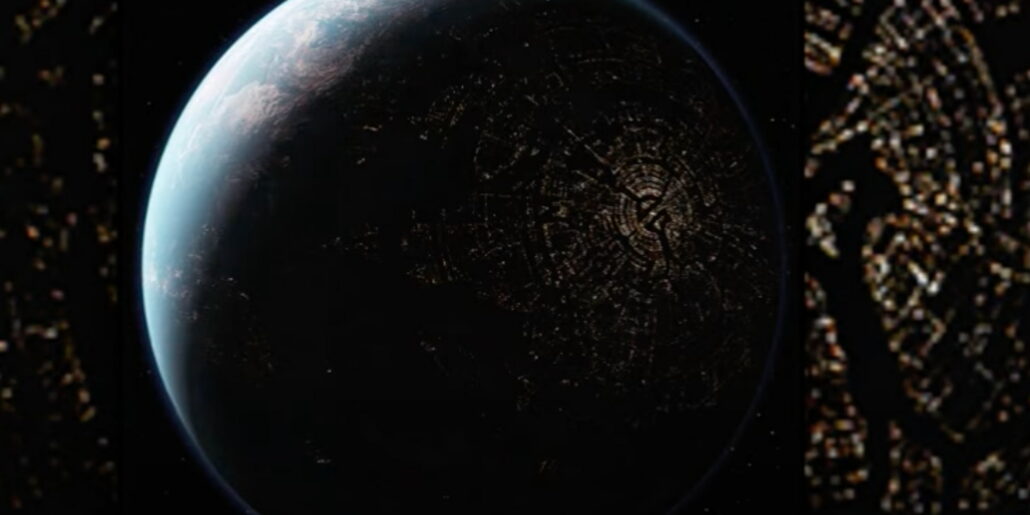Delve into the intricate details surrounding the annihilation of entire celestial bodies in the Hosnian System during the events of The Force Awakens.
This article presents a comprehensive guide to the doomed star system, the catastrophic power of the Starkiller Base, and the protagonists involved in these cataclysmic events.
Heavenly Bodies Decimated by the Starkiller Installation
In the saga’s seventh installment, Star Wars introduced a formidable armament, eclipsing even the power of the Death Star: the Starkiller Base. While the original Death Star could eradicate individual celestial bodies, the Starkiller Base had the capacity to obliterate entire star systems.
Comparatively, the original Death Star from the 1977 installment pulverized the celestial body known as Alderaan. However, the Starkiller Base went several steps further by decimating five celestial bodies in a single maneuver. Which celestial bodies fell victim to this devastating power? The entire Hosnian System was annihilated, including the seat of the New Republic.
Unpacking the Starkiller Installation and the Fateful Hosnian System
The 2015 installment known as The Force Awakens was pivotal in unveiling a new trilogy in the Star Wars narrative. The feature showcased crucial Resistance figures like Rey, Finn, and Poe Dameron, who stepped in as the successors to the Rebellion. Additionally, the audience was introduced to the menacing First Order, which emerged following the Empire’s downfall. Leadership of this terrifying entity was shared among figures like General Hux, Supreme Leader Snoke, and Kylo Ren.
In the same installment, viewers were shown the terrifying Starkiller Installation, a weapon of mass destruction, clandestinely built deep within the Unknown Regions on a celestial body named Ilum. The installation had the ability to harvest a star’s energy by manipulating the magnetic fields within Ilum’s core. This energy was then transformed into a cataclysmic beam that could traverse hyperspace and strike the galaxy’s Core regions.
The Hosnian System was positioned in the Core regions and housed five celestial bodies, including the politically significant Hosnian Prime. Tragically, Hosnian Prime was also the location of the New Republic Senate, symbolizing a new, democratic interstellar order.
Starkiller’s Aim and Impact: A Detailed Account
Known also as the Hosnian Cataclysm or the Starkiller Incident, the decimation of the Hosnian System transpired roughly three decades after the events of Return of the Jedi. The initial aim was set on Hosnian Prime, the hub for the Galactic Senate.
- The First Order considered the New Republic to be an unauthorized regime and thus chose to utilize its Starkiller installation to eradicate it. The mechanism caused a subatomic reaction in Hosnian Prime’s core, leading to a supernova-like event that instantly converted the celestial body into a quasi-star. This calamitous blast wiped out not only the Senate but also a critical segment of the New Republic’s naval forces;
- In addition to Hosnian Prime, four other celestial bodies—Courtsilius, Raysho, Hosnian, and Cardota—were in the orbit of the same star and were consequently annihilated by the weapon’s malevolent energy ray;
- In the aftermath of this astronomical calamity, General Leia orchestrated an assault team to counterattack the Starkiller Installation, setting the stage for an epic confrontation.
By breaking down these events, this analysis aims to offer an intricate understanding of the celestial bodies destroyed, the entities involved, and the subsequent actions taken by key figures in the Star Wars universe.
The Resistance’s Critical Counter-Offensive on Starkiller Base
The Resistance orchestrated a pivotal strike on the Starkiller Base, disarming it just moments prior to its planned incineration of D’Qar— the location housing the Resistance’s main operations.
Immediate Consequences Averted: Had this offensive by the Resistance been unsuccessful, not only would D’Qar have met its end, but the Starkiller Base’s celestial body count would have escalated from five to six.
Termination of the Cold War Era Between Galactic Entities
This assault by Starkiller Base served as the trigger to conclude the stagnant tensions that had been termed the ‘Cold War’ between the New Republic and the First Order.
- State of Affairs Before: Until this point, there was an uneasy equilibrium between the New Republic and the First Order, devoid of substantial military confrontations;
- Post-Incident Changes: With the cessation of this period, outright hostilities broke out, allowing the First Order to begin their aggressive territorial gains across the galaxy.
An Alternate Reality: Starkiller Base Targeting Coruscant
In the narrative arc of The Force Awakens, there was a point during development where the Starkiller Base’s devastating beam almost set its sights on Coruscant, as opposed to the Hosnian System.
- Original Capital: Known for its diverse culture, towering architectural wonders, and a bustling population that soared into the trillions, Coruscant had been the capital of the Old Republic in prior installments;
- Evolution of Capital Cities: Upon the ascendance of the Empire, Coruscant transitioned into being the hub of imperial activities and trade networks. Following the Empire’s downfall, the Hosnian Prime took the mantle as the capital of the New Republic.
Decision-Making Dynamics Behind The Target Selection
One of the senior figures at Lucasfilm disclosed how Coruscant was initially a primary candidate to face the Starkiller Base’s cataclysmic power. This same authority confirmed that a consensus was reached for Hosnian Prime to bear the brunt instead.
- Reasoning Behind the Shift: It’s suggested that Coruscant was eventually ruled out due to its deep-rooted history and its ongoing relevance to multiple Star Wars endeavors in development;
- Strategic Importance: Further contributing to this decision was the strategic significance of Coruscant, making it a prize the First Order would likely prefer to capture rather than annihilate.
Concept Art vs. Final Decisions
Additional details point out that the original concept artwork was heavily leaning towards Coruscant as the Starkiller Base’s primary focus. However, the Hosnian System was deemed a more appropriate choice, considering it was a fresh celestial setting where the New Republic had relocated its operations.
Significance of the Hosnian System: Being the center of the New Republic’s governance structure, the Hosnian System, by contrast, was a new entity and thus more expendable in the storyline.
The Death Stars and Their Destructive Feats
The debut of the first Death Star in the original Star Wars saga, specifically in “A New Hope,” left viewers aghast with its cataclysmic abilities. The celestial body it eradicated initially was none other than Alderaan, the home of Princess Leia. However, its path of annihilation did not begin there.
- Pre-Alderaan Targets: Prior to Alderaan, the nearly finalized Death Star took part in a failed offensive against Rebel forces and annihilated the starfighter carrier known as Fortressa. Subsequently, its superlaser was trained on Despayre;
- Significance of Despayre: Serving as a penal colony, Despayre was also the final construction site of the first Death Star. Grand Moff Tarkin chose it for a devastating demonstration, resulting in an astronomical loss of life.
Earlier Versions and Other Targets
Before the Death Star became the terror it was known to be, there existed a predecessor prototype, which aimed to eliminate a celestial body in the Kessel system.
- Targeting Error: This earlier iteration was not perfectly fine-tuned; hence, it missed its original target—Kessel—and impacted one of its moons;
- Surviving Fragments: Remarkably, a significant chunk of this Garrison moon weathered the destructive power of the prototype, adding a twist to the prototype’s grim legacy.
Escalation of Destructive Power: The Starkiller Base
The Starkiller Base, introduced in “The Force Awakens,” set new standards for the potential scale of galactic weaponry. It far surpassed the destruction meted out by Death Stars in prior cinematic installments.

Enhanced Devastation: Unlike the Death Stars, the Starkiller Base demonstrated the ability to obliterate a complete system of five celestial bodies with just a singular discharge.
Tactical Implications of Death Stars vs. Starkiller Base
The introduction of these superweapons had substantial tactical ramifications. The Death Stars were primarily offensive assets, targeted at single celestial bodies to serve political ends.
On the other hand, the Starkiller Base was a strategic nightmare, capable of wiping out entire star systems, thus creating voids in the galaxy’s military and political landscapes. This expanded its potential uses beyond mere intimidation to full-fledged galactic reshaping.
The Societal Impact of Superweapons
Beyond the immediate loss of life and terrain, the presence of these superweapons had a deep impact on the collective psyche of the galaxy’s populace.
Death Stars and Starkiller Base became symbols of dread, their mere existence inciting fear and submission. This psychological component became a secondary weapon, furthering the dark aims of those who controlled these monstrosities.
Conclusion
In the Star Wars universe, the theme of escalation is vividly embodied in the progression from Death Stars to the Starkiller Base. While the Death Stars were undeniably terrifying, their ability to wreak havoc was dwarfed by the Starkiller Base’s capacity for system-wide obliteration.
The evolution of these superweapons isn’t just a narrative tool but also a reflection on the consequences—both tactical and psychological—that such leaps in destructive technology can have. Their existence in the cinematic realm serves as a harrowing reminder of the ethical dilemmas and existential threats that advanced weaponry can bring to bear in any universe.
